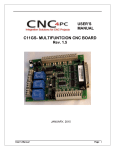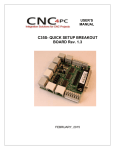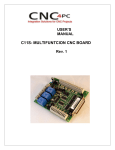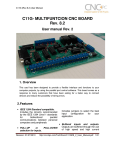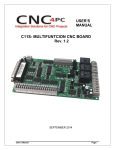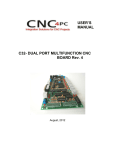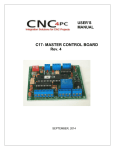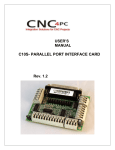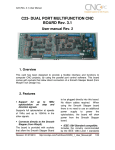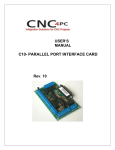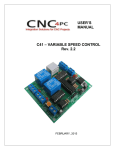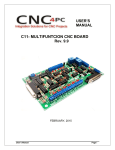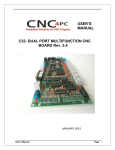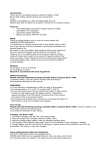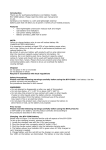Download User`s Manual Template
Transcript
USER’S MANUAL C11GS- MULTIFUNTCION CNC BOARD Rev. 1.1 November, 2013 USER'S MANUAL TABLE OF CONTENTS Page # 1. OVERVIEW ......................................................................................................................... 2 2. FEATURES ......................................................................................................................... 2 3. SPECIFICATIONS .............................................................................................................. 4 4. BOARD DESCRIPTION ...................................................................................................... 5 5. SPECIAL FUNCTIONS ....................................................................................................... 6 6. FUNCTIONAL BLOCK DIAGRAMS ................................................................................. 14 7. WIRING DIAGRAMS ........................................................................................................ 17 8. TROUBLESHOOTING. ............................................................Error! Bookmark not defined. 9. DIMENSIONS ................................................................................................................... 22 10. FREQUENTY ASKED QUESTIONS: ............................................................................ 23 User’s Manual Page i 1. OVERVIEW This card has been designed to provide a flexible interface and functions to your computer projects by using the parallel port or USB-based or Ethernet-based controller. This board comes as a response to many customers that have been asking for a faster way to connect devices and reduce the possibility of wiring errors. 2. FEATURES IEEE 1284 Standard compatible. Includes the circuitry recommended by the IEEE 1284 Level 1 standards for bidirectional parallel communications between personal computers and peripherals. PULL-UP or PULL-DOWN selection for inputs. Includes jumpers to select the best input configuration for your application. Buffered inputs and outputs. Outputs are buffered through the use of high speed and high current buffers allowing the card to output the signals without using the power from the parallel port. It can take the +3.3 or +5vdc signal from the parallel port and deliver solid +5vdc at 24 milliamps. Microcontroller based SCHP. This board comes with a microcontroller that allows the implementation of a complex algorithm for sampling and analyzing the SCHP signal. Built-in Variable Speed Control. It has an optoisolated analog 0- 10VDC output that will convert a PWM signal into an analog signal that can be used to command a commercial VFD. This analog can be adjusted using an on-board potentiometer, so this board can be adjusted to other voltages. 3 Electromechanical Relays with NO and NC positions. Mechanical relays are very flexible because they can be used for AC or DC and come with NO and NC (Normally Open and Normally Closed) positions. Status LEDs on all inputs and output connections. No more guessing. You can SEE all your signals. Save valuable time and brainpower for CNCing. To avoid remaining current to the main load (driver or other device), all the indicator LEDs are driven by independent buffers of the ones that drive de output. User’s Manual Page 2 Output pins 1, 2, 3, 4, 5, 6, 7, 8, 9, 14, 16 and 17. Input pins 10, 11, 12, 13 and 15. Input and output pins close to ground or +5vdc connections Common terminal for pins 2-9 can be ground or +5vdc. Forget about grounding problems. Easily connect your pin by using your close by ground connection. No need to be an electronics expert to ground all your stuff. The board has a jumper that allows you to select if the common terminal to pins 2-9 will carry a ground or +5vdc. So if you are connecting encoders or proximity switches, you can select it to ground. If you are connecting Gecko drives or limit switches, you can set It to be +5VDC. External Enable Pin (EN). The board has a pin that allows you to enable/disable all the outputs at once. The board requires +5vdc in the EN pin. If it is not present, it will send all the outputs to ground. You can use this to enable or disable the system manually, or you can install an external Safety Charge Pump or other external safety monitoring device. Works directly with popular CNC hardware and software. Such as Gecko drive or Leadshine, and parallel port control software, such as mach2, Linux EMC, Turbo CNC, and others. (Not all tested). All TTL 5VDC signals. Interface directly with parallel port interface products and other CNC4PC cards. 5VDC (TTL) cards are very common among automation devices. Screw-On connections for all terminals. You only have to screw-on the wires to make all your connections. All pins can be used in a concurrent manner. You can use all the input or output pins in a concurrent manner. For example, if you are using output pin #1 to control the Built-in Electromechanical Relay, you can also access that signal from the output pin on the board or from the DB25 connector for output. Each connection will not affect the other current from the other connection. User’s Manual Page 3 3. SPECIFICATIONS DIGITAL INPUT SPECIFICATIONS On-state voltage range 2 to 5V DC Maximum off-state voltaje 0.8V Maximum operation frequency 4 MHz Typical signal delay 10nS DIGITAL OUTPUT SPECIFICATIONS (5V power supply voltage) + Maximum output voltage 0.5V Typical output current 24mA Maximum off-state voltaje 0.44 V Maximum operation frequency 4 MHz Typical signal delay 10 nS Time of transition to high impedance state 12 nS* *Time passed since a low in the ENABLE input is detected and the outputs are disabled Requirements: It requires a 5VDC @ 1000 milliamps power supply to operate. WARNING Check the polarity and voltage of the external power source and connect the 5V and GND. Overvoltage or reverse-polarity power applied to these terminals can cause damage to the board, and/or the power source. User’s Manual Page 4 4. BOARD DESCRIPTION User’s Manual Page 5 Board Pinout 5. SPECIAL FUNCTIONS 5.1 Safety Charge Pump “SCHP”. (Pin 17) This board takes advantage of Mach ability to send a specific frequency through one of the pins of the parallel port when the program is in control of the system. CNC machinery can be very dangerous, and you could have a risk of the machine doing something different that what you intend the machine to do if the program loses control of your system. Mach be can be programmed in a way, so when it is “in control”, it delivers a 12.5 KHz signal through one of the pins. This card lets you use this signal to work as an On/Off switch for your system, enabling a powerful safety system for your equipment. If you ever had windows crash on you, then this card is for you. The port can also do weird things while the system is coming up, or down. For Configuring the Charge Pump in Mach X: Use the dialog Config / Ports and pins / Output Signals. Enable the Charge Pump output and configures it as is shown in the Fig. 8 Next, press the apply button. User’s Manual Page 6 Charge Pump configuration User’s Manual Page 7 Selecting the SCHP operation mode. The Safety Charge Pump can be activated or deactivated depending on the jumper position 1-2: SCHP OFF 2-3: SCHP ON , Note: When the Safety Charge Pump is activated, the EN terminal is active and a valid SCHP signal is present, pin 17 will go high. This high signal can be used to enable other external devices, such as enabling other Breakout Boards, or relays that would enable servos, VFDs, contactors etc…. 5.2 Variable Speed Control. (pin 14 and 16) This function lets you control your spindle with PWM signal. It converts the PWM signal into an analog (0-10VDC). This function can also be used on many DC motor controllers by replacing the potentiometer that controls the speed. Requirements: It requires a +12VDC@ 30mA power supply to operate. WARNING: To keep the output signals optoisolated, these must not have common ground or connections to current with other circuits you are using. You will require a voltmeter to fine tune your system. Wiring: Before connecting anything, please be sure to read your VFD’s manual and make sure you understand all the safety issues. Operation Mode Jumper User’s Manual Page 8 Operation mode jumpers This jumper allows selecting the way how the relays go to be activated when a PWM signal and REV signal are present in the inputs terminals. See the tables below. US MODE (INT) INPUTS PWM (Pin 14) ON ON OFF OFF REV(Pin 16) ON OFF ON OFF RELAYS REL 1 OFF ON OFF OFF REL 2 ON OFF OFF OFF INTERNATIONAL MODE (INT) INPUTS PWM (Pin 14) ON ON OFF OFF REV(Pin 16) ON OFF ON OFF RELAYS REL 1 ON ON OFF OFF REL 2 ON OFF OFF OFF Relay 1 and 2 They can be used to control the VFD. The relay specification are shown in the below table. ELECTROMECHANICAL RELAYS SPECIFICACTIONS 7A@240VAC; Maximun Current (AC) 10A@125VAC 15A@524VDC; Maximun Current (DC) 10A@28VDC User’s Manual Page 9 Electromechanical Relays Specifications. Configuring the Control Software: It is strongly recommend you read your control software’s manual. You need to configure your control software to control the spindle as if it was an angular axis. This card requires a PWM input signal to deliver 10VDC. So you have to set the speed of the motor (spindle) at maximum. For acceleration values adjust them to where you feel comfortable. Keep in mind the acceleration of the motor must also be set in your VFD. For configuring Mach follow these steps: 1. Go to Config / Ports &Pins / Motor Outputs. Enable the spindle and select the port and pins you wired for step and direction. Ports & Pins configuration screenshot 2. Go to Config / Ports &Pins / Spindle Setup. In the motor control box, check Use Spindle Motor Output and Step /Dir Motor. Under Pulley Ratios set the pulley ratios of the machine. User’s Manual Page 10 Spindle Setup screenshot Go to Config / Motor Tuning / Spindle. On Steps per unit put 1,000, set velocity to maximum. For Acceleration, choose the acceleration that you feel comfortable with. Start slow, increase acceleration as you test your system. Under Step Pulse length, use a number from 3 to 5, but start with 3. This number is directly proportional to the final voltage you will get in the analog output. Use this number and the fine tuning pot to adjust the voltage you want to get at max speed. Motor Tuning and Setup screenshot. After configuring the Mach, these steps should be followed. User’s Manual Page 11 Replacing a Potentiometer: This circuit can be used to replace a potentiometer of DC motor speed control circuits. This speed controller circuits are very commonly used by SIEG, KB Electronics, and many other oriental machines. Before explaining how to do it, please first keep in mind that it can be done if the voltage that goes though the pot is +12vdc or less. This circuit cannot be used for AC currents. In most cases the terminals that go to the potentiometer will carry these signals: P1 = GND P2 = WIPER P3 = REFERENCE VOLTAGE These are the steps for replacing a potentiometer: 1. Measure the voltage difference between P1 and P3. Make sure it measures under +12vdc. 2. Fine tune the analog output to the output voltage you got from step 1. 3. Connect the ground from the analog output to the ground of the potentiometer (P1). 4. Connect the analog output to the wiper connection of the potentiometer (P2). After configuring the Mach, these steps should be followed. Step 1. Ensure that all external power sources are set to OFF. Step 2. Connect the power supply to the Power Inputs Connectors (X1). Step 3. Turn on the external supplies Step 4. Connect a voltmeter in the analog outputs connectors (X2) and make and fine tune this output: Make sure that when you reach the max speed in the control software you get 10VDC out (X2). This voltage can vary depending on many things, including the electrical properties of parallel port or breakout board you are using, the length of the step pulse your software is delivering, and the normal hi or low status of your step pin. Play with the pot, hi/low status of the pin, and pulse length to fine tune the output voltage. User’s Manual Page 12 5.3 Electromechanical relays. (REL 3 “Pin 17”) Mechanical relays are very flexible because they can be used for AC or DC and come with NO and NC (Normally Open and Normally Closed) positions. The relay specification are shown in the below table. ELECTROMECHANICAL RELAYS SPECIFICACTIONS 7A@240VAC; Maximun Current (AC) 10A@125VAC 15A@524VDC; Maximun Current (DC) 10A@28VDC Electromechanical Relays Specifications. 5.4 Using the COM configuration jumper. This is for selecting the value to get at the COM terminals found next to step and direction terminals (Pin 2-9). Some drivers expect a ground, and others expect +5vdc. There is a jumper (X7) that allows you to select +5VDC or GND for the COM pins. 1-2: COM= 5V 2-3: COM= GND 5.5 External Enable Pin. The card must be provided with a 5VDC signal to enable operation. This feature has been added to externally control the status of the outputs. An external switch or a Safety Charge Pump can be added to provide the enabling signal. When the enable signal is not present, output signals sent high impedance state. If this function is not required, an jumper can be placed between +5vdc and the EN terminal. It has an internal 4.7kOhm pull-down resistor. User’s Manual Page 13 WARNING: This card must have the power supplied while it is connected to the PC. If power is removed to the card while it is connected to the PC, noise can be introduced to the output lines. This can create a dangerous situation as relays or other devices that might be connected to this card could get activated. 6. FUNCTIONAL BLOCK DIAGRAMS 6.1 Outputs 2-9 simplified functional block diagram Simplified functional block diagram for the outputs 2-9. User’s Manual Page 14 Parallel Port coupling is done following IEEE 1284 standard recommendation. The indicator led is driven by a different buffer. 6.2 Outputs 1, 14, 16 and 17 simplified functional block diagram 7. Simplified functional block diagram for the outputs 1, 14, 16 and 17. Note: “Internal Enable” = “External Enable Pin” AND (“SCHP” OR “Bypassed SCHP”) The “Internal Enable” is the result of an AND Operation between the “External Enable Pin” and the SCHP operation mode selected by the user. Note: All Outputs will be deactivated if the board is not connected to the PC parallel port. User’s Manual Page 15 6.3 Input simplified functional block diagram Simplified functional block diagram for the inputs. Pins 10, 11, 12, 13 and 15 can be set to pull-down or pull-up by selecting the jumper in the appropriate position. The input pins can be set to be pulled up or down with a 4.7Kohm resistor. 1-2: PULL-UP 2-3: PULL- DOWN User’s Manual Page 16 7. WIRING DIAGRAMS While this board supports only TTL +5VDC signals, different kind of sensors, switches using different voltages can be connected using the diagrams that follow: Note: The below wiring diagrams are an example, any input can be used for the connections. Note. The bellow wiring diagrams require setting the inputs to use pull-down resistor. 7.1 Connecting Switches or push button. Wiring diagram to connect switches. 7.2 Connecting NPN sensors. Wiring diagram to connect NPN open collector proximity sensors. User’s Manual Page 17 Wiring diagram to connect in parallel NPN open collector proximity sensors. Connecting NPN open collector proximity sensor with the C11GS R1 Value (12V) R1 Value (24V) Aprox. 10KΩ Aprox. 25KΩ Wiring diagram to connect NPN proximity sensors with internal pull up resistor. User’s Manual Page 18 Some NPN proximity sensor has a pull-up resistor (R1) internally. It is necessary to know its value in order to connect safely the sensor with the BOB. Follow this recommendation: Connecting NPN open collector proximity sensor with the C11GS (R1+R2) Value (12V) (R1+R2) Value (24V) Aprox. 10KΩ Aprox. 25KΩ Calculating the R1 value. Note: Rx is the unknown resistor value. RX = VEX. (R/V) - R (1) Where: VEX is the external power supply voltage V is the voltage across the R resistor An external resistor and a voltmeter are required to calculate the internal resistor (Rx) value. Note. The user should know the R value to do this operation. A 4.7KOhm @ 1/2W is recommended. SAMPLE: if you are using a 12V power supply (VEX), and using a 4.7KOhm as external resistor (R), then the voltage across R should be 6V, using the equation 1, the Rx value is 4.7KOhm. 7.3 Connecting PNP sensors. User’s Manual Page 19 Wiring diagram to connect PNP proximity sensors Connecting PNP proximity sensor with the C11GS 7.4 R Value (12V) R Value (24V) Aprox. 10KΩ Aprox. 25KΩ Other connection. Other connections can be implemented by setting the inputs to pull-up resistor. User’s Manual Page 20 Wiring diagram to do an “Auto Tool Zero” http://cnc4pc.com/Tech_Docs/E_STOP_N_EN_Wiring.pdf http://cnc4pc.com/Tech_Docs/E_STOP_N_SCHP.pdf User’s Manual Page 21 8. DIMENSIONS All dimensions are in Millimeters User’s Manual Page 22 9. FREQUENTY ASKED QUESTIONS: Q: The power LED on the board can light even if the board is not connected to power. Is this normal? A: Yes, the board can steal enough power from the parallel port to light the LED, not for reliable operation. An external regulated 5vdc that can supply at least 500mA should be used. If you are worried about false signals triggering out, you should use the EN terminal to disable the outputs. Q: I have power the board and connect it to the drivers, but the signals do not get to the drivers. A: Three conditions must be met to enable the outputs and allow signals to get through: - The board needs to be connected to a PC using a parallel cable that uses pins 1-25 as there is a watchdog on pins 18 and 19 that disables the outputs if the board is not connected to a PC. There are some parallel cables out there that use only pins 1-17, use a multimeter to verify continuity between these pins. - You should have 5vdc on the EN terminal. This is for external hardware disable on the board. You can use a jumper between the 5vdc in the power terminal and the EN terminal. - In the case of boards with built in Safety Charge Pump, the SCHP must be configured and active, or you can disable the SCHP in the board by moving the jumper to the disable position. DISCLAIMER: Use caution. CNC machines can be dangerous machines. Neither DUNCAN USA, LLC nor Arturo Duncan are liable for any accidents resulting from the improper use of these devices. This board is not a fail-safe device and it should not be used in life support systems or in other devices where its failure or possible erratic operation could cause property damage, bodily injury or loss of life. User’s Manual Page 23
























